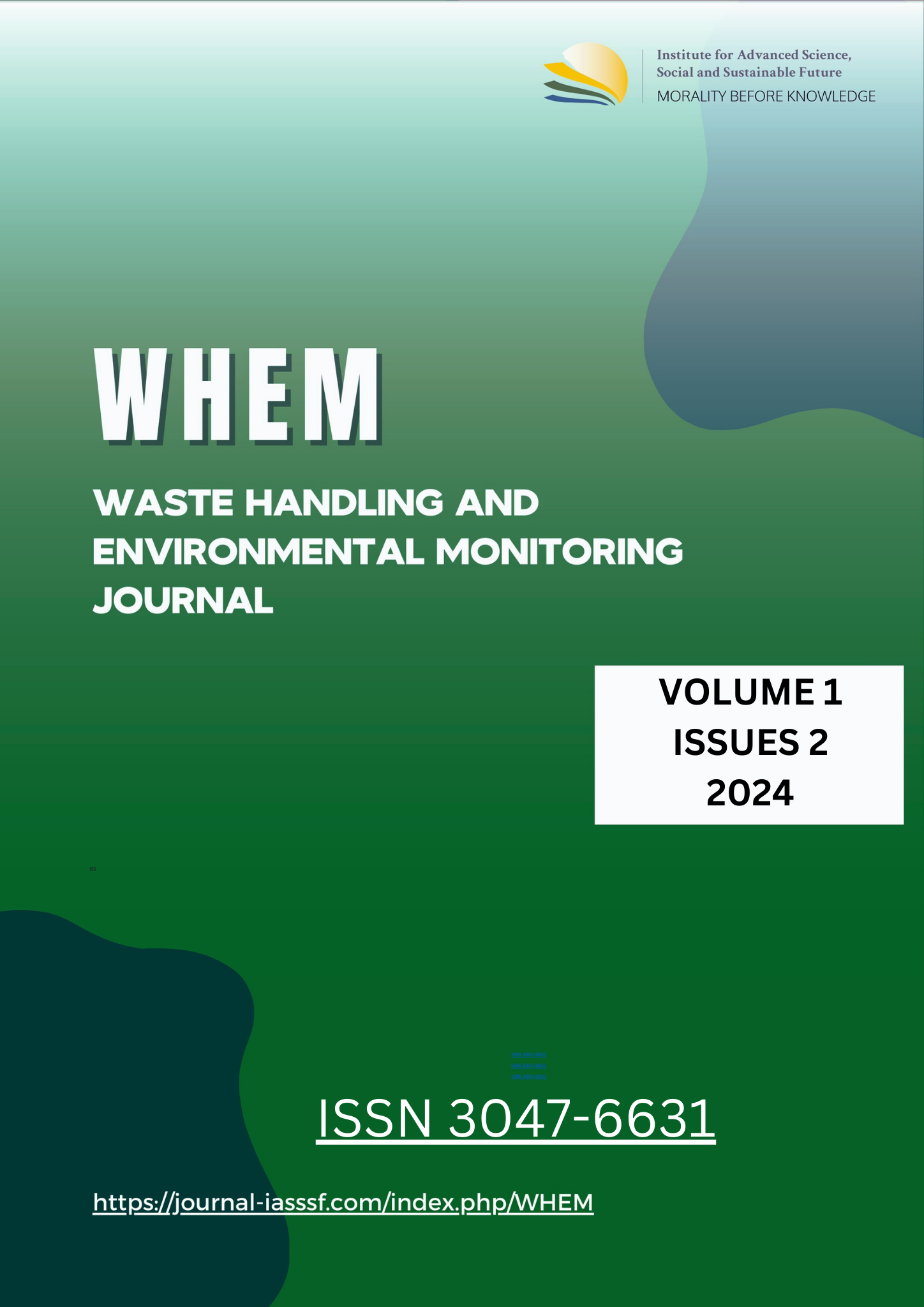Spatial analysis of zinc (Zn) heavy metal distribution in the waters of Staring Bay, Southeast Sulawesi
DOI:
https://doi.org/10.61511/whem.v1i2.2024.1206Keywords:
heavy metal Zn, spatial analysis, staring bay, inverse distance weight (IDW), contaminant factor (CF)Abstract
Background: A spatial study of the distribution of heavy metal zinc (Zn) in the waters of Staring Bay, Southeast Sulawesi, has been conducted. This research aims to determine the spatial distribution of heavy metal Zn in the waters of Staring Bay. Methods: Sampling was carried out at 12 stations in the bay using a purposive sampling method. The concentration of heavy metal Zn in seawater samples was determined using an Atomic Absorption Spectrophotometer (AAS). Spatial analysis was performed using the Inverse Distance Weight (IDW) interpolation method (power = 2) with data processing software (ArcGIS 10.1). Findings: The results of the study indicate that the Zn metal concentration at the 12 research stations ranges from 0.0141 to 0.2085 ppm, with an average of 0.0668 ppm. The highest concentration of Zn metal is found at station 1. The results of the spatial analysis, with 12 stations, show that the area from the open sea to the coast of Tanjung Tiram Village has been contaminated with Zn heavy metal, ranging from 0.0132 to 0.2085 ppm. The same contamination is observed in the northern part of Wawosunggu Island, from the river mouth near Rumbia-rumbia Village to Lara Island, which has also been contaminated with a range of 0.0572 to 0.2085 ppm. Conclusion: Based on the contaminant factor (CF) values, the highest contamination by Zn metal occurs at station 1. Environmental variables (salinity, pH, temperature) show no significant effect on the concentration of Zn heavy metal. Novelty/Originality of this article: This study provides a comprehensive spatial analysis of zinc (Zn) contamination in Staring Bay, highlighting critical areas of pollution. It uniquely employs the Inverse Distance Weight interpolation method, revealing significant contamination patterns with minimal influence from environmental variables.
References
Armid, A., Shinjo, R., Zaeni, A., Sani, A., & Ruslan, R. (2014). The distribution of heavy metals including Pb, Cd and Cr in Kendari Bay surficial sediments. Marine pollution bulletin, 84(1-2), 373-378. https://doi.org/10.1016/j.marpolbul.2014.05.021
Bangun, J. M. (2005). Kandungan logam berat timbal (Pb) dan kadmium (Cd) dalam air, sedimen dan organ tubuh ikan sokang (Triancanthus nieuhofi) di Perairan Ancol, Teluk Jakarta. Skripsi. Bogor. Institut Pertanian Bogor. https://repository.ipb.ac.id/handle/123456789/11543
Bosch, A. C., O'Neill, B., Sigge, G. O., Kerwath, S. E., & Hoffman, L. C. (2016). Heavy metals in marine fish meat and consumer health: a review. Journal of the Science of Food and Agriculture, 96(1), 32-48. https://doi.org/10.1002/jsfa.7360
Firmansyaf, D., Yulianto, B., & Sedjati, S. (2013). Studi Kandungan Logam Berat Besi (Fe) Dalam Air, Sedimen Dan Jaringan Lunak Kerang Darah (Anadara granosa Linn) Di Sungai Morosari Dan Sungai Gonjol Kecamatan Sayung, Kabupaten Demak. Journal of Marine Research, 2(2), 45-54. https://doi.org/10.14710/jmr.v2i2.2350
Kementerian Lingkungan Hidup, Peraturan Menteri Lingkungan Hidup Republik Indonesia Nomor 5 Tahun 2014 Tentang Baku Mutu Air Limbah. No. 96. Kementerian Lingkungan Hidup.
Li, H., Lin, L., Ye, S., Li, H., & Fan, J. (2017). Assessment of nutrient and heavy metal contamination in the seawater and sediment of Yalujiang Estuary. Marine Pollution Bulletin, 117(1-2), 499-506. https://doi.org/10.1016/j.marpolbul.2017.01.069
Li, X., Chi, W., Tian, H., Zhang, Y., & Zhu, Z. (2019). Probabilistic ecological risk assessment of heavy metals in western Laizhou Bay, Shandong Province, China. PLoS One, 14(3), e0213011. https://doi.org/10.1371/journal.pone.0213011
Rachmawati, R., Ma'ruf, W. F., & Anggo, A. D. (2013). Pengaruh lama perebusan kerang darah (Anadara granosa) dengan arang aktif terhadap pengurangan kadar logam kadmium dan kadar logam timbal. Jurnal Pengolahan dan Bioteknologi Hasil Perikanan, 2(4), 41-50. https://ejournal3.undip.ac.id/index.php/jpbhp/article/view/3802
Reichelt-Brushett, A. J., & McOrist, G. (2003). Trace metals in the living and nonliving components of scleractinian corals. Marine Pollution Bulletin, 46(12), 1573-1582. https://doi.org/10.1016/S0025-326X(03)00323-0
Riyanto. (2014). Validasi dan verifikasi metode uji. Deepublish.
Santika, Y. E. Analisis Status Mutu Air dengan Metode Indeks Pencemaran Berdasarkan Parameter Fisika-Kimia di Sungai Beji, Desa Pondok, Kecamatan Karanganom, Kabupaten Klaten. Ekosains, 16(1). https://jurnal.uns.ac.id/ekosains/article/view/84231
Supriharyono, M. S. (2000). Pelestarian Pengelolaan Sumber Daya Alam di Wilayah Pesisir Tropis. PT Gramedia Pustaka Utama.
Susanto, A., Pratomo, H., & Rahman, A. (2015). Analisis Cemaran Limbah Industri dan Domestik terhadap Biota Laut di Perairan Kota Tanjungpinang, Provinsi Kepulauan Riau. Jurnal Air Indonesia, 8(2).https://dx.doi.org/10.29122/jai.v8i2.2373
Wang, X., Zhao, L., Xu, H., & Zhang, X. (2018). Spatial and seasonal characteristics of dissolved heavy metals in the surface seawater of the Yellow River Estuary, China. Marine pollution bulletin, 137, 465-473. https://doi.org/10.1016/j.marpolbul.2018.10.052
Wardhani, E. K. A., Sutisna, M., & Dewi, A. H. (2012). Evaluasi pemanfaatan abu terbang (fly ash) batubara sebagai campuran media tanam pada tanaman tomat (Solanum lycopersicum). Jurnal Itenas Rekayasa, 16(1). https://ejurnal.itenas.ac.id/index.php/rekayasa/article/view/438
Zhang, A., Wang, L., Zhao, S., Yang, X., Zhao, Q., Zhang, X., & Yuan, X. (2017). Heavy metals in seawater and sediments from the northern Liaodong Bay of China: Levels, distribution and potential risks. Regional Studies in Marine Science, 11, 32-42. https://doi.org/10.1038/s41467-018-06802-0
Zhang, J., Zhou, F., Chen, C., Sun, X., Shi, Y., Zhao, H., & Chen, F. (2018). Spatial distribution and correlation characteristics of heavy metals in the seawater, suspended particulate matter and sediments in Zhanjiang Bay, China. PLoS One, 13(8), e0201414. https://doi.org/10.1371/journal.pone.0201414
Downloads
Published
How to Cite
Issue
Section
Citation Check
License
Copyright (c) 2024 Waste Handling and Environmental Monitoring

This work is licensed under a Creative Commons Attribution 4.0 International License.

















